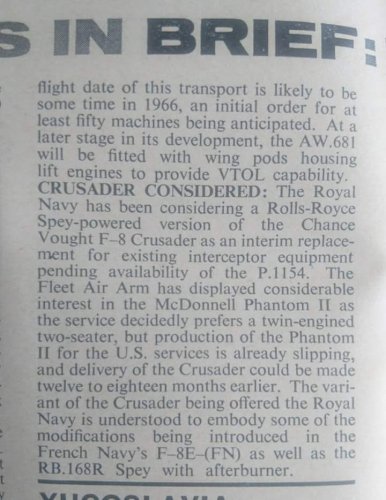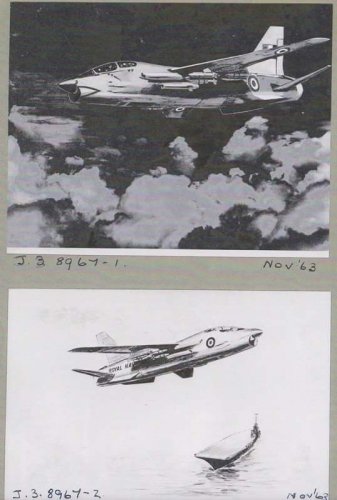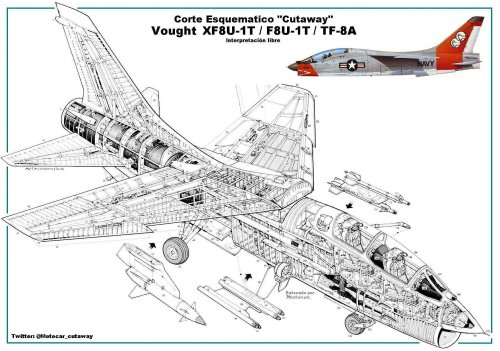You are using an out of date browser. It may not display this or other websites correctly.
You should upgrade or use an alternative browser.
You should upgrade or use an alternative browser.
Vought two-seat F-8 for the UK
- Thread starter Archibald
- Start date
- Joined
- 29 September 2006
- Messages
- 1,794
- Reaction score
- 1,360
TsrJoe said:note 'flippped' carrier in lower image
And with a non-apparent angled deck.
The Shorts Crusader would have been interesting indeed. Any problems with the planes and the chaps at the Royal Naval Air Yard, Sydenham, could have taken a walk over to Shorts and asked for aid (or complained).
Im sure models of the UK. F.8 designs will appear, its just figuring out what the actual proposals looked like ? ie IF Spey engined, bigger intake?, repositioned refuelling probe?, back end changes? revised two seat configuration? B)
- Joined
- 19 July 2016
- Messages
- 4,279
- Reaction score
- 3,464
That is something to look forward to.
- Joined
- 21 May 2006
- Messages
- 3,002
- Reaction score
- 2,280
TsrJoe said:'Flying Review International', 19/2, October 1963
I find it interesting that the article emphasises –
The Royal Navy has been considering a Rolls Royce-powered version of the Chance Vought F-8 Crusader as an interim replacement for existing interceptor equipment pending availability of the P. 1154
Regards
Pioneer
- Joined
- 17 October 2006
- Messages
- 2,393
- Reaction score
- 1,197
I love the F-8 as much as the next guy, but the idea of a heavier, more powerful version on a smallish carrier gives me the willies.
- Joined
- 26 September 2008
- Messages
- 1,960
- Reaction score
- 746
LowObservable said:I love the F-8 as much as the next guy, but the idea of a heavier, more powerful version on a smallish carrier gives me the willies.
A-3s were operating off of Essex carriers.
But they were not supersonic. The Whale was a gentle fat fellow of aircraft. The Crusader was quite tricky to land. Recently wrapped my mind around losses of the French ones. Well... 42 bought, 26 crashed. 
- Joined
- 15 July 2007
- Messages
- 4,889
- Reaction score
- 4,553
Over how long a time?Archibald said:But they were not supersonic. The Whale was a gentle fat fellow of aircraft. The Crusader was quite tricky to land. Recently wrapped my mind around losses of the French ones. Well... 42 bought, 26 crashed.
One even managed to get under a carrier with it , then back on it alive (without the cruze though...)
http://aviateurs.e-monsite.com/pages/1946-et-annees-suivantes/sous-un-porte-avions-et-vivant.html
(sorry french text, but goooogle translate should be ok)
http://aviateurs.e-monsite.com/pages/1946-et-annees-suivantes/sous-un-porte-avions-et-vivant.html
(sorry french text, but goooogle translate should be ok)
Question regarding this. I've contacted an artist to make a sideview of this variant in RN livery, wih a few variations in equipment, but would the RN version have had two or four 20 mm cannons? The trainer version deleted the left-hand cannons to make room for displaced avionics, but all the art for this projects seems to indicate that the RN plane would have had four 20 mm cannons.
Can anyone shed light on this?
Also, my google-fu in this isn't very good. How much larger in diameter would both intake and exhaust have been for the Spey engine?
Can anyone shed light on this?
Also, my google-fu in this isn't very good. How much larger in diameter would both intake and exhaust have been for the Spey engine?
- Joined
- 15 July 2007
- Messages
- 4,889
- Reaction score
- 4,553
How serious was the proposal?
Because the RN and RAF had move away from 20cm years earlier to the 30mm.
So it's questionable why they'd run seperate ammo supply just to avoid fitting the F8 with 30mm ADEN cannon.
Because the RN and RAF had move away from 20cm years earlier to the 30mm.
So it's questionable why they'd run seperate ammo supply just to avoid fitting the F8 with 30mm ADEN cannon.
MihoshiK said:I've contacted an artist to make a sideview of this variant in RN livery
Here are some for you:
Initial:
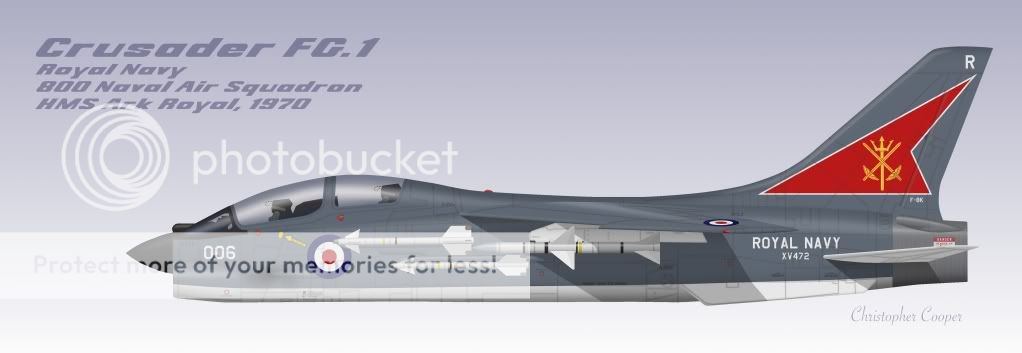
Low Viz:
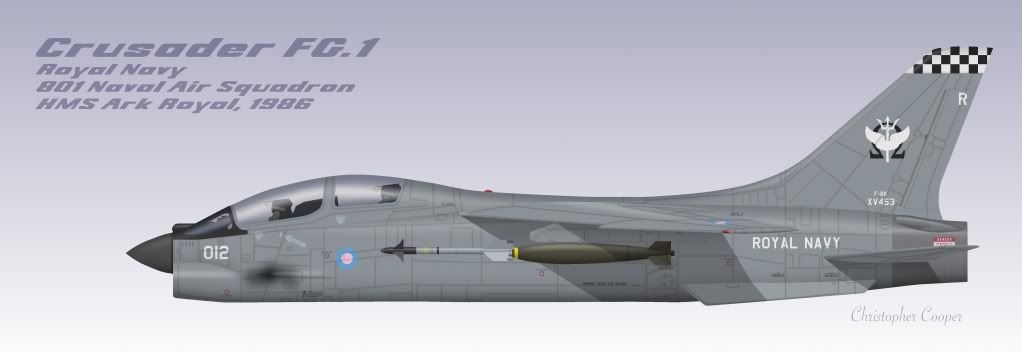
In RAF scheme:
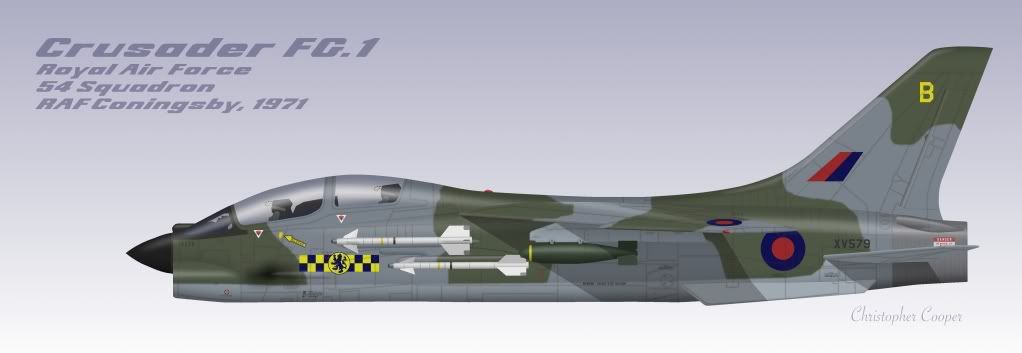
I have a bunch of others too if you want them - just let me know.
_Del_
I really should change my personal text... Or not.
- Joined
- 4 January 2012
- Messages
- 1,315
- Reaction score
- 1,812
It's a looker for sure.GTX said:MihoshiK said:I've contacted an artist to make a sideview of this variant in RN livery
Here are some for you:
Initial:

Actually, is there anything that doesn't look good in that scheme?
These are very nice indeed, excellent work. If there's any gripe to be had is that they ignore the engine issues: The Spey would need a larger intake and exhaust .GTX said:MihoshiK said:I've contacted an artist to make a sideview of this variant in RN livery
Here are some for you:
Initial:

I have a bunch of others too if you want them - just let me know.
Apart from that they're pretty amazing.
Do you have a website or an Artstation or Deviantart with your work somewhere?
MihoshiK said:Do you have a website or an Artstation or Deviantart with your work somewhere?
These are not my work - they are of Chris Cooper (see 'signature' on images). They were done purely for hobby purposes. You can see some of his other work here or here. He also worked with me to illustrate a number of alternative history stories on Beyond the Sprues.
zen said:How serious was the proposal?
Because the RN and RAF had move away from 20cm years earlier to the 30mm.
So it's questionable why they'd run seperate ammo supply just to avoid fitting the F8 with 30mm ADEN cannon.
On the other hand, the RN and RAF never adopted the 30-mm ADEN for the Phantom, even though they could have. They used the external, 20-mm Vulcan pod.
I imagine that, had the Crusader been selected, the choice of gun (and other equipment) would have been made by balancing the cost of customizations (enormous in the case of the Spey, if the Phantom is any guide) against all the other costs. Rolls Royce got the engine for the Phantom mainly because it was such an important employer and a mainstay of the English aviation industry. Perhaps the makers of the ADEN would not have had the same pull. And, given the significant British content represented by the engine, the USN 20-mm might have been acceptable. After all, it was basically an advanced version of the familiar Hispano.
Then again, given the all-missile fad of the era, the RN and RAF might have omitted the guns altogether in favor of fuel or additional British avionics.
MihoshiK said:These are very nice indeed, excellent work. If there's any gripe to be had is that they ignore the engine issues: The Spey would need a larger intake and exhaust .
Apart from that they're pretty amazing.
I'd also question the Sparrow/Skyflash. The F-8 never carried them--it probably lacked the right radar fire-control system.
- Joined
- 20 January 2007
- Messages
- 953
- Reaction score
- 1,143
#64: Rolls Royce got the engine for the Phantom mainly because it was such an important employer and a mainstay of the English aviation industry. Not back then. The Magic of a Name is itself a phantom.
Ministers put big reheated Olympus into TSR.2 and arranged Formation 1/4/59 of BSEL to produce it after they had been briefed that RB.142R would have been inferior.
Ministers then threw it in free as entry ticket to Concorde, 29/11/62: free, in that it was presented as a derivative of B.Ol.22R, so only installation R&D would fall to the joint project.
Overload, maybe, yet Ministers rejected deflected, reheated Twin Spey 25/3/63 for the Joint Service P.1154. Though dry Spey was by then funded for Buccaneer S.2, timescale risk was seen as less in Pegasus' Big Brother.
At that point RR was parlous: numerous schemes for Speys, but little on the shop floor. BSEL was owned by HS Group and a rump Bristol Holding entity: the 2 Chairmen, Sir Roy Dobson and Sir R. Verdon Roe gently sounded Ministers on their receptiveness to an Offer for RR. Ministers dithered over monopoly (already there, of their own creation), so the Knights chose to wait to cherry-pick any juicy windfall when RR withered. RR was funded late-63 for a big-fan Demonstrator (run 7/66 as RB.178), 9/63 for Medway for, maybe 40, HS.681, and had a plethora of part-German-funded V/STOL objects...but what might flow from these, when? But then came the cry: the Navy's here!
CVA-01 was committed 7/63, Ark/Eagle/Victorious confirmed to remain (RN hoped...until CVA-02/03). RN ratcheted up their efforts from 1959 to Meet in St.Louis for a proper warplane, absent since Corsairs/Hellcats were lost in 1946. They carried the cases: for 2 engines; for cross-operation with USN F-4B; and the bolter case - that F-4B with GE J79 would not respond to slam reheat before ditching off the CVs. P.1154(RN) chopped and 52 F-4K/Spey ordered 27/2/64.
McNamara had funded (to be) F-4C, 3/62: phalanxes of Phantoms: why would RN contemplate the also-ran Crusader? The French took it in 1963 because, BLC/&tc.-modified, it could, as F-4B (was judged) could not, operate off Foch/Clemenceau. When P.1154(RAF) and its BS.100 were evidently for the chop (done, 2/65), RAF wanted F-4C-as-is, please, NOW! F-8(UK)/Twosader were paper-not-in-the-sky. RAF had no choice but to acquiesce in fewer F-4M/Spey than could have been bought as F-4(UK-J79): who would support duplication in a UK-peculiar F-8, whether licensed and/or Speyed? Or who would support J79 in RAF, Spey in RN F-4s?
Spey was built to match MDC production rates, and was taken as F-111K offset to be built by Allison to similar delivery rates for A-7D/E. B.Ol.593 by early-1966 was evidently a pyrrhic victory, as big-fans swept the market. With its business base now greater than BSEL's, RR bought them, 10/66 (the Bristol 50%, HSAL's 50% bought 1/68). A big fan became pyrrhic for RR, 4/2/71.
Ministers put big reheated Olympus into TSR.2 and arranged Formation 1/4/59 of BSEL to produce it after they had been briefed that RB.142R would have been inferior.
Ministers then threw it in free as entry ticket to Concorde, 29/11/62: free, in that it was presented as a derivative of B.Ol.22R, so only installation R&D would fall to the joint project.
Overload, maybe, yet Ministers rejected deflected, reheated Twin Spey 25/3/63 for the Joint Service P.1154. Though dry Spey was by then funded for Buccaneer S.2, timescale risk was seen as less in Pegasus' Big Brother.
At that point RR was parlous: numerous schemes for Speys, but little on the shop floor. BSEL was owned by HS Group and a rump Bristol Holding entity: the 2 Chairmen, Sir Roy Dobson and Sir R. Verdon Roe gently sounded Ministers on their receptiveness to an Offer for RR. Ministers dithered over monopoly (already there, of their own creation), so the Knights chose to wait to cherry-pick any juicy windfall when RR withered. RR was funded late-63 for a big-fan Demonstrator (run 7/66 as RB.178), 9/63 for Medway for, maybe 40, HS.681, and had a plethora of part-German-funded V/STOL objects...but what might flow from these, when? But then came the cry: the Navy's here!
CVA-01 was committed 7/63, Ark/Eagle/Victorious confirmed to remain (RN hoped...until CVA-02/03). RN ratcheted up their efforts from 1959 to Meet in St.Louis for a proper warplane, absent since Corsairs/Hellcats were lost in 1946. They carried the cases: for 2 engines; for cross-operation with USN F-4B; and the bolter case - that F-4B with GE J79 would not respond to slam reheat before ditching off the CVs. P.1154(RN) chopped and 52 F-4K/Spey ordered 27/2/64.
McNamara had funded (to be) F-4C, 3/62: phalanxes of Phantoms: why would RN contemplate the also-ran Crusader? The French took it in 1963 because, BLC/&tc.-modified, it could, as F-4B (was judged) could not, operate off Foch/Clemenceau. When P.1154(RAF) and its BS.100 were evidently for the chop (done, 2/65), RAF wanted F-4C-as-is, please, NOW! F-8(UK)/Twosader were paper-not-in-the-sky. RAF had no choice but to acquiesce in fewer F-4M/Spey than could have been bought as F-4(UK-J79): who would support duplication in a UK-peculiar F-8, whether licensed and/or Speyed? Or who would support J79 in RAF, Spey in RN F-4s?
Spey was built to match MDC production rates, and was taken as F-111K offset to be built by Allison to similar delivery rates for A-7D/E. B.Ol.593 by early-1966 was evidently a pyrrhic victory, as big-fans swept the market. With its business base now greater than BSEL's, RR bought them, 10/66 (the Bristol 50%, HSAL's 50% bought 1/68). A big fan became pyrrhic for RR, 4/2/71.
- Joined
- 15 July 2007
- Messages
- 4,889
- Reaction score
- 4,553
No, Spey was rejected from 1154, because RR had shipped out all the supersonic components to meet weight requirements. On discovery their proposal was rejected.
Point is Spey needed supersonic components to meet performance, without them it was no better than in production Speys for the Buccaneer and in turn this tells us how different and how much was needed in development to get that supersonic Spey.
RN had had P1154 foisted on them, (they'd thought it OK for an Attack machine as part of their TAU, but this was chopped in favour of more Buccaneer/Strike machines able to do Attack as well), in order to get it taken off their backs they flat ruled out all single engine aircraft, even when earlier they'd looked at the F8UIII for a Scimitar successor.
RN FAA wanted a decent fighter/radar/missile NOW (1963) after seeing Soviet AShM's.
Point is Spey needed supersonic components to meet performance, without them it was no better than in production Speys for the Buccaneer and in turn this tells us how different and how much was needed in development to get that supersonic Spey.
RN had had P1154 foisted on them, (they'd thought it OK for an Attack machine as part of their TAU, but this was chopped in favour of more Buccaneer/Strike machines able to do Attack as well), in order to get it taken off their backs they flat ruled out all single engine aircraft, even when earlier they'd looked at the F8UIII for a Scimitar successor.
RN FAA wanted a decent fighter/radar/missile NOW (1963) after seeing Soviet AShM's.
So, I said I'd asked someone to make some variants. The artist is HandofManos.
Intake, fuselage and exhaust are slightly enlarged from the original.
Enjoy.
Intake, fuselage and exhaust are slightly enlarged from the original.
Enjoy.
Attachments
-
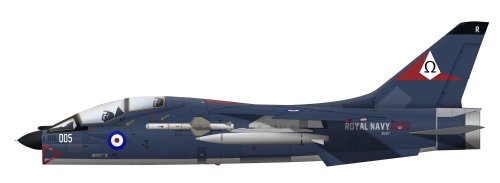 f8ucrusaderredtop_by_handofmanos-dcdq6dz.jpg344.3 KB · Views: 594
f8ucrusaderredtop_by_handofmanos-dcdq6dz.jpg344.3 KB · Views: 594 -
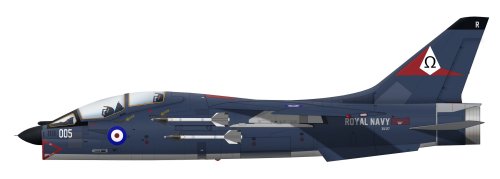 f8ucrusadersidewinder_by_handofmanos-dcdq6dl.jpg343.8 KB · Views: 524
f8ucrusadersidewinder_by_handofmanos-dcdq6dl.jpg343.8 KB · Views: 524 -
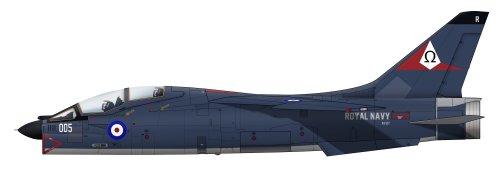 f8ucrusadertrainer_by_handofmanos-dcdq6dd.jpg349.5 KB · Views: 491
f8ucrusadertrainer_by_handofmanos-dcdq6dd.jpg349.5 KB · Views: 491 -
 f8ucrusaderzuni_by_handofmanos-dcdq6ed.jpg333.2 KB · Views: 286
f8ucrusaderzuni_by_handofmanos-dcdq6ed.jpg333.2 KB · Views: 286 -
 f8ucrusader_by_handofmanos-dcdh45c.jpg263.1 KB · Views: 288
f8ucrusader_by_handofmanos-dcdh45c.jpg263.1 KB · Views: 288
I like the use of Redtops
- Joined
- 27 December 2005
- Messages
- 17,748
- Reaction score
- 26,422
Red Top and AI23 would be interesting. Wonder if AI23 would have fit?
- Joined
- 17 October 2006
- Messages
- 2,393
- Reaction score
- 1,197
Red Tops - loaded (literally) for Bear.
And another fascinating perspective from Alertken, resident Man of Mystery.
And another fascinating perspective from Alertken, resident Man of Mystery.
PaulMM (Overscan) said:Wonder if AI23 would have fit?
Not sure about the rest of the radar but the dish size of the AI.23 and AN/APQ-94 (as fitted to later F-8s) was both 21" so on that front it would work.
BlackBat242
OK, I changed my personal text ;)
- Joined
- 10 April 2013
- Messages
- 1,482
- Reaction score
- 4,292
iverson said:I imagine that, had the Crusader been selected, the choice of gun (and other equipment) would have been made by balancing the cost of customizations (enormous in the case of the Spey, if the Phantom is any guide) against all the other costs. Rolls Royce got the engine for the Phantom mainly because it was such an important employer and a mainstay of the English aviation industry.
There were two problems with the Spey in the Phantom.
1st: engine size.
J79-15 (F-4B): length 208.5", diameter engine body 30.4", diameter afterburner 38.3", weight 3,630 lb
RB168-25 (FG.1): length 205", diameter engine body 37.5", diameter afterburner 44", weight 4,093 lb
This required redesign of the lower aft fuselage structure to fit the larger diameter engines.
2nd: airflow.
J79 ~170 lb/sec
RB168-25 ~210 lb/sec
This required the intakes and ducting to be enlarged in cross-section area to allow the higher mass of air to reach the engines unimpeded, this required redesign of the outer fuselage side structure, and altered the airflow over the fuselage in an adverse manner (higher drag).
The J57 of the Crusader was a larger engine than the Spey in most respects, and would require fewer airframe structural changes (mainly around the afterburner, and just minor adjustments in the intake & ducting).
J57-20 (F-8E): length 235.2", diameter engine body 40.02", diameter afterburner 40.02", weight 4,750 lb, airflow ~200 lb/sec
- Joined
- 15 July 2007
- Messages
- 4,889
- Reaction score
- 4,553
PaulMM (Overscan) said:UK Crusader
(Project stillborn by June 1964)
Built by Short Bros in Harland
RB.168-25R Spey turbofan, 12,000lb dry, 20,000lb reheat
Based on two seat TF-8, but equipped for pilot & navigator
Front fuselage development and production by Short, with rest of fuselage imported from Vought in the US, for assembly in Belfast.
With Spey, 50% British
Unit cost only slightly above French purchase price (£500,000)
French system of double leading and trailing edge droops, together with (BLC) blown ailerons and flaps
Could be made compatible with Firestreak and Red Top
Source:
Flying Review International June 1964
Lets just reiterate that projected cost of F4 at decision time was 1.2 million, so the option of F8 for 0.5 million would have been quite competitive.
That the Spey F4 spiralled to over 3 million per plane is irrelevant to that decision but it's certainly plausible that the Spey F8 wouldn't suffer such a huge increase in price.
In theory the FAA could've afforded over 240 aircraft.
- Joined
- 27 December 2005
- Messages
- 17,748
- Reaction score
- 26,422
zen said:PaulMM (Overscan) said:UK Crusader
(Project stillborn by June 1964)
Built by Short Bros in Harland
RB.168-25R Spey turbofan, 12,000lb dry, 20,000lb reheat
Based on two seat TF-8, but equipped for pilot & navigator
Front fuselage development and production by Short, with rest of fuselage imported from Vought in the US, for assembly in Belfast.
With Spey, 50% British
Unit cost only slightly above French purchase price (£500,000)
French system of double leading and trailing edge droops, together with (BLC) blown ailerons and flaps
Could be made compatible with Firestreak and Red Top
Source:
Flying Review International June 1964
Lets just reiterate that projected cost of F4 at decision time was 1.2 million, so the option of F8 for 0.5 million would have been quite competitive.
That the Spey F4 spiralled to over 3 million per plane is irrelevant to that decision but it's certainly plausible that the Spey F8 wouldn't suffer such a huge increase in price.
In theory the FAA could've afforded over 240 aircraft.
My confidence in execution rises in inverse proportion to how much work was to be done by Shorts. More than one successful Shorts bid seems to have been awarded on a "job creation" basis, not on merit.
Similar threads
-
-
Vought Crusader for F-X (1962) instead of Northrop F-5A
- Started by Archibald
- Replies: 18
-
-
-
M148T - Early Buccaneer and it's rivals
- Started by ChuckAnderson
- Replies: 59

